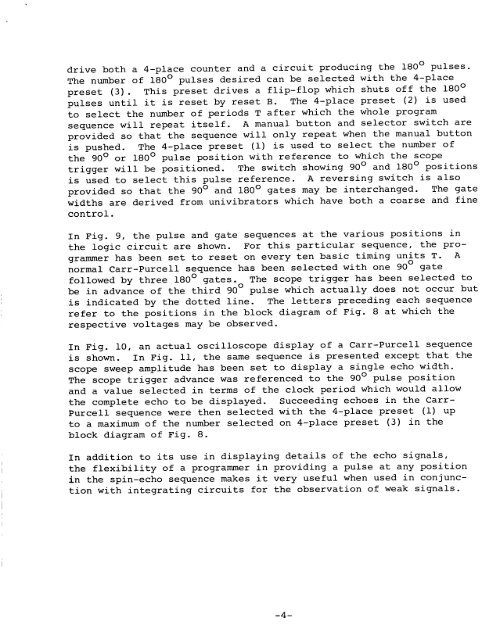rd - 1962 - ENC Conference
rd - 1962 - ENC Conference
rd - 1962 - ENC Conference
You also want an ePaper? Increase the reach of your titles
YUMPU automatically turns print PDFs into web optimized ePapers that Google loves.
drive both a 4-place counter and a circuit producing the 180 ° pulses.<br />
The number of 180 ° pulses desired can be selected with the 4-place<br />
preset (3). This preset drives a flip-flop which shuts off the 180 °<br />
pulses until it is reset by reset B. The 4-place preset (2) is used<br />
to select the number of periods T after which the whole program<br />
sequence will repeat itself. A manual button and selector switch are<br />
provided so that the sequence will only repeat when the manual button<br />
is pushed. The 4-place preset (i) is used to select the number of<br />
the 90 ° or 180 ° pulse position with reference to which the scope<br />
trigger will be positioned. The switch showing 90 ° and 180 ° positions<br />
is used to select this pulse reference. A reversing switch is also<br />
provided so that the 90 ° and 180 ° gates may be interchanged. The gate<br />
widths are derived from univibrators which have both a coarse and fine<br />
control.<br />
In Fig. 9, the pulse and gate sequences at the various positions in<br />
the logic circuit are shown. For this particular sequence, the pro-<br />
grammer has been set to reset on every ten basic timing units T. A<br />
normal Carr-Purcell sequence has been selected with one 90 ° gate<br />
followed by three 180 ° gates° The scope trigger has been selected to<br />
be in advance of the thi<strong>rd</strong> 90 ° pulse which actually does not occur but<br />
is indicated by the dotted line. The letters preceding each sequence<br />
refer to the positions in the block diagram of Fig. 8 at which the<br />
respective voltages may be observed.<br />
In Fig. 10, an actual oscilloscope display of a Carr-Purcell sequence<br />
is shown. In Fig. ii, the same sequence is presented except that the<br />
scope sweep amplitude has been set to display a single echo width.<br />
The scope trigger advance was referenced to the 90 ° pulse position<br />
and a value selected in terms of the clock period which would allow<br />
the complete echo to be displayed. Succeeding echoes in the Carr-<br />
Purcell sequence were then selected with the 4-place preset (i) up<br />
to a maximum of the number selected on 4-place preset (3) in the<br />
block diagram of Fig. 8.<br />
In addition to its use in displaying details of the echo signals,<br />
the flexibility of a programmer in providing a pulse at any position<br />
in the spin-echo sequence makes it very useful when used in conjunc-<br />
tion with integrating circuits for the observation of weak signals.<br />
-4-













